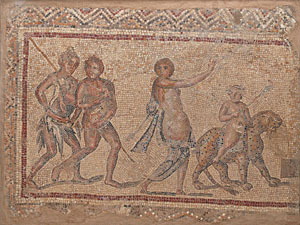 | This fragment of the Yale Art Gallery's newly acquired mosaic -- measuring roughly 35 by 26 inches -- shows a boy on a panther's back followed by a maenad and two satyrs. It comes from the ancient city of Gerasa in modern-day Jordan, a site Yale helped excavate in the late 1920s and early 1930s. |
The Yale University Art Gallery has acquired five major fragments of a floor mosaic from a second-century house at the ancient city of Gerasa (present-day Jerash in the northern part of Jordan).
The fragments, part of a mosaic showing figures and scenes from classical mythology, feature an outer border of two muses, Euterpe and Erato, and a processional scene in which Dionysos and Ariadne ride in a four-wheeled wagon drawn by piping centaurs. The procession also includes images of the god Pan riding on a goat, a boy riding on a panther and several erotes, satyrs and maenads.
A large portion of the same floor is in Berlin's Pergamon Museum, and additional fragments are in the Kelsey Museum in Ann Arbor, and in the Wheaton College Museum of Art, as well as a private collection in New York.
The Yale Art Gallery already owns a few mosaics, almost all from Gerasa, a site that Yale excavated jointly with the British School in the late 1920s and early 1930s. The mosaics already in the University's collection are in a linear outlined, flat proto-Byzantine style from sixth-century churches, while the new acquisitions are in an illusionistic classical style from a second-century house.
"Mosaics are one of the major art forms from the ancient Greek and Roman worlds," says Susan B. Matheson, the Molly and Walter Bareiss Curator of Ancient Art. "With this acquisition, it will be possible to provide a representative picture of style, technique and iconography in ancient classical and early Byzantine mosaics from the same city over the space of 400 years."
This acquisition was made possible through the Ruth Elizabeth White Fund. A passionate collector of antiquities, White (of Southbury, Connecticut) decided after a visit to the Yale Art Gallery in 1988 that the teaching museum would make the best use of her collection. Upon her death in 1998, she bequeathed more than $4 million for the acquisition of objects in the fields of Greek, Roman and Etruscan art and for publications related to ancient art.
T H I S
Yale Art Gallery acquires
floor mosaic from ancient city
 W E E K ' S
W E E K ' S S T O R I E S
S T O R I E S![]()
 Levin named to review panel on intelligence operations
Levin named to review panel on intelligence operations![]()
![]()
 Scientist gets $6 million for study of Parkinson's disease
Scientist gets $6 million for study of Parkinson's disease
![]()
![]()
 U.S. poet laureate appointed as Rosenkranz Writer-in-Residence
U.S. poet laureate appointed as Rosenkranz Writer-in-Residence
![]()
![]()
 Yale Rep stages a 'King Lear' for the ages
Yale Rep stages a 'King Lear' for the ages
![]()
![]()
 Yale Rep's 'King Lear': A classic tale in an ancient setting
Yale Rep's 'King Lear': A classic tale in an ancient setting
![]()
![]()
 YHHAP: They don't just work for the homeless, but with them
YHHAP: They don't just work for the homeless, but with them
![]()
![]()
 Yale Art Gallery acquires floor mosaic from ancient city
Yale Art Gallery acquires floor mosaic from ancient city
![]()
![]()
 Graduate School again increases stipends for doctoral students
Graduate School again increases stipends for doctoral students
![]()
![]()
 President re-establishes Minority Advisory Council
President re-establishes Minority Advisory Council
![]()
![]()
 Exhibition features 'Big and Green' architectural designs
Exhibition features 'Big and Green' architectural designs
![]()
![]()
 Law practitioners to explore 'rebellious' strategies for change
Law practitioners to explore 'rebellious' strategies for change
![]()
![]()
 Yale's NCAA self-study is available to community online
Yale's NCAA self-study is available to community online
![]()
![]()
 Scientists discover low level of enzyme in people with epilepsy
Scientists discover low level of enzyme in people with epilepsy
![]()
![]()
 Event explores challenges of children in foster care . . .
Event explores challenges of children in foster care . . .
![]()
![]()
 Japanese puppetry to open Yale Rep's Special Event series
Japanese puppetry to open Yale Rep's Special Event series
![]()
![]()
 Panetti piece celebrating work with quartet to make East Coast premiere
Panetti piece celebrating work with quartet to make East Coast premiere
![]()
![]()
 Yale scholars Snyder and Gay honored . . .
Yale scholars Snyder and Gay honored . . .
![]()
![]()
 Yale Books in Brief
Yale Books in Brief
![]()
![]()
 Campus Notes
Campus Notes
![]()
Bulletin Home |
| Visiting on Campus
Visiting on Campus |
| Calendar of Events
Calendar of Events |
| In the News
In the News![]()
Bulletin Board |
| Classified Ads
Classified Ads |
| Search Archives
Search Archives |
| Deadlines
Deadlines![]()
Bulletin Staff |
| Public Affairs
Public Affairs |
| News Releases
News Releases |
| E-Mail Us
E-Mail Us |
| Yale Home
Yale Home